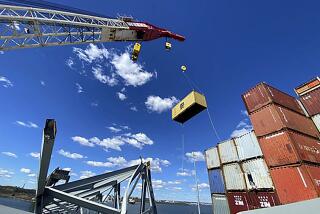Divers Finish Big Cuts on Tanker : Last of Jutting Steel Plates Removed From Exxon Valdez
- Share via
Divers cutting away at the damaged hull of the Exxon Valdez have removed all seven steel pieces jutting from the ship, and Monday trimmed a large patch of steel that had begun to blister, officials said.
The last of the sagging plates--two smaller pieces, each about 20 feet long--and minor patches of steel sagging from the hull were cut off the tanker’s bottom by the salvage divers Monday. Another two or three days will be needed for the trimming.
Monday, the crippled vessel drifted about 5 miles off San Clemente Island amid swells up to 3 feet, the Coast Guard reported.
“Sea conditions have allowed them to make good progress. The priority now is to make sure we don’t have any additional plates that fall,” said Jan Cool, a spokeswoman for Exxon Shipping Co. “The attempt now is to make sure we’re stabilizing the situation with the hull and eliminating further deterioration. At this point, we feel like we’ve been able to arrest the danger by removing these plates.”
Drifting Offshore
Representatives of the state and Exxon Shipping Co., after several days of deliberation, continued Monday to review final drafts of an agreement to allow the ship to enter state waters for repairs.
An Assembly committee on oil-spill prevention and response is meeting in San Diego today to hear testimony about the condition of the Valdez since it arrived offshore San Diego on July 10.
Representatives of Exxon, the Coast Guard, several state agencies, local environmental organizations and San Diego County are expected to testify.
The Valdez was towed to San Diego from Alaska for repairs after smashing into a reef on March 24 and spilling 11 million gallons of crude oil along the Prince William Sound shoreline.
But the tanker has been drifting off San Diego after the discovery of the jutting plates and an 18-mile oil slick believed to have come from the ship delayed its entry into San Diego Bay.
No discharges of a bluish mixture of weathered oil and marine life, observed coming from the ship several days after its arrival, have been seen for eight days, the Coast Guard reported.
Some Concerns Voiced
All seven pieces of steel, some up to 70 feet long and weighing 50 tons apiece, were allowed to drop to the ocean floor 3,000 feet below the ship because of concerns for the divers’ safety, officials said.
The dropping of the plates is not expected to harm the marine environment, Exxon and state officials said. But local environmentalists voiced some concern about the decision.
“I don’t think it’s going to do major damage to the environment. Compared to the damage that’s already been done by the Valdez, this is minuscule,” said Rick Nadeau, director of Greenpeace in San Diego. “But, if they have the technology to remove (the plates), they should. The fact is, we’re dumping all kinds of things into the ocean. This is just one more thing.”
The plates, peeled back from the hull during the tanker’s transit from Prince William Sound, prevent the vessel from clearing the bottom of San Diego Bay, where it is expected to dry-dock at National Steel & Shipbuilding Co. for a nine-month, $25-million repair job.
Officials originally had planned to move the ship, now about 5 miles off San Clemente Island in federal waters, into state waters, which extend up to 3 miles from the coast, to remove the plates.
The Coast Guard gave Exxon permission to remove the plates in federal waters, but the company will have to abide by conditions set by the state when it enters San Diego Bay, officials said.
More to Read
Sign up for Essential California
The most important California stories and recommendations in your inbox every morning.
You may occasionally receive promotional content from the Los Angeles Times.













